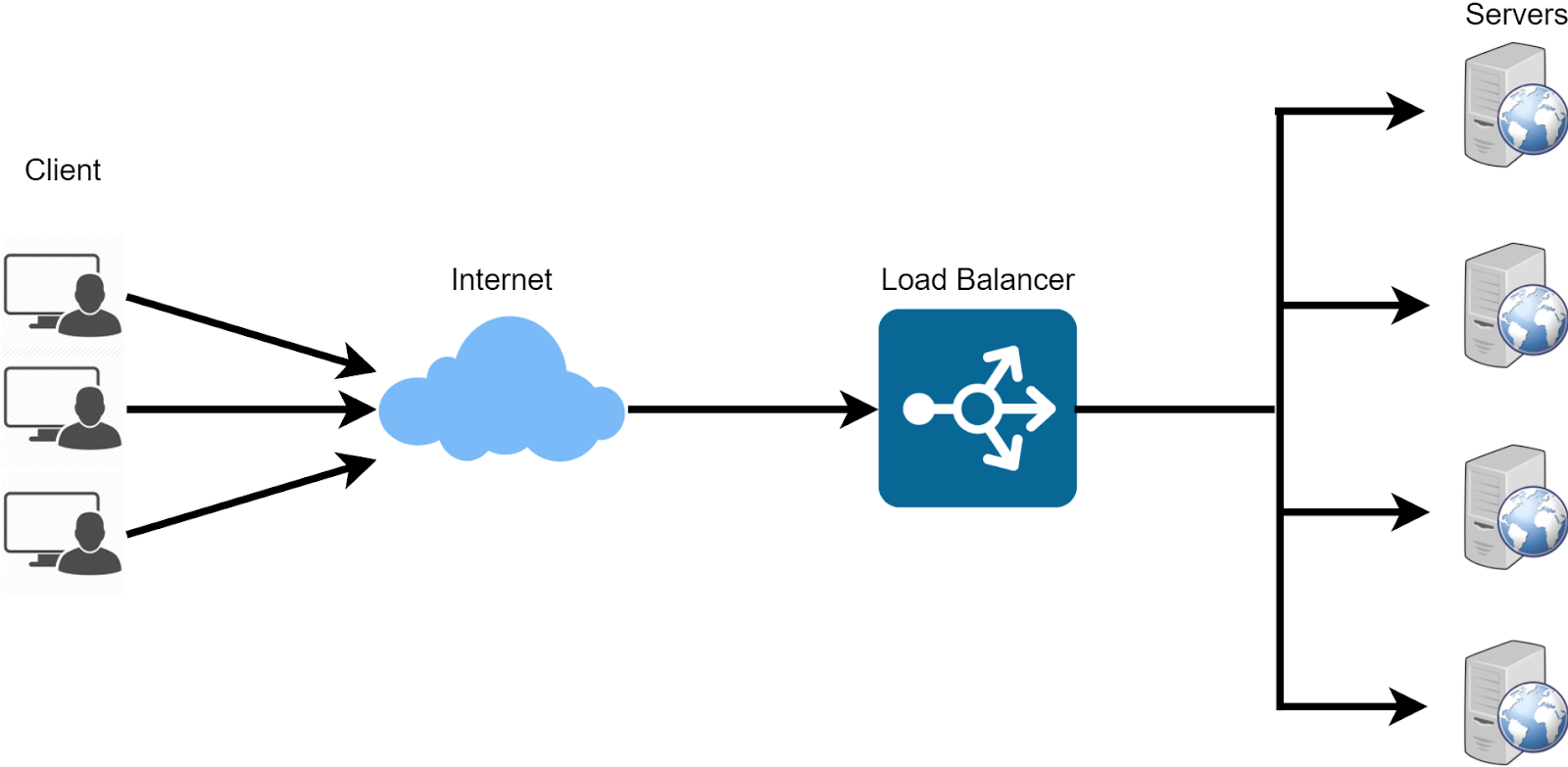Mastering Application Performance: What Is Load Balancers?
In the bustling world of modern IT infrastructure, load balancers play a critical role in ensuring seamless user experiences and resilient application performance. As unsung heroes, these versatile tools distribute incoming traffic across multiple servers, preventing overload and ensuring high availability. For any software development company aiming to deliver robust applications, understanding “what is load balancers” is essential for optimizing your IT environment. Whether you’re a seasoned IT professional or a budding enthusiast, mastering the intricacies of load balancing is key to maintaining efficient and reliable systems.

Understand What Is Load Balancers?
Understanding What Is Load Balancers?
Understanding these benefits highlights the critical role of load balancers in maintaining the smooth operation and scalability of modern applications. By leveraging load balancers, businesses can ensure their IT infrastructure is resilient, efficient, and capable of delivering high-quality service to users.
Unveiling the Essence of Load Balancers
At its core, load balancing revolves around optimizing resource utilization within IT environments. Imagine a scenario where a single server is inundated with requests. Without a load balancer, this overload could lead to sluggish performance or even system failures. Load balancers step in to distribute incoming traffic across multiple servers, preventing bottlenecks and ensuring efficient resource allocation. They act as intelligent traffic controllers, dynamically routing requests to the most suitable servers based on predefined algorithms. These algorithms can be based on various factors such as server load, geographical location, or the type of request.
Load balancers come in different types, including hardware-based solutions, software-based solutions, and cloud-based services. Each type has its own set of features and benefits tailored to different IT infrastructure needs. For instance, hardware load balancers are known for their high performance and reliability, while software load balancers offer flexibility and ease of deployment.
Why Load Balancers are Crucial in Modern IT Architectures
Load balancers offer a plethora of benefits that are indispensable for today’s applications:
-
Scalability: Load balancers make it easy to scale applications by adding or removing servers from the pool without causing downtime. This elasticity is particularly useful for handling varying levels of demand, ensuring that the application can handle spikes in traffic smoothly.
-
Availability: By distributing requests across multiple servers, load balancers enhance the availability of applications. If one server fails, the load balancer can redirect traffic to other healthy servers, maintaining uninterrupted service for users. This fault tolerance is critical for maintaining high availability and reliability.
-
Performance: Load balancers optimize response times by directing requests to the least loaded servers. This intelligent routing helps improve the overall performance of applications, providing a faster and more efficient user experience. Load balancers can also perform health checks to ensure that requests are only sent to servers that are functioning correctly.
-
Security: Load balancers can also enhance security by hiding the internal server infrastructure from external users. They can be configured to include additional security features such as SSL offloading, which handles the encryption and decryption of data, thus reducing the load on application servers.
-
Flexibility: Modern load balancers support a variety of routing algorithms and can be configured to meet specific application requirements. They can distribute traffic based on round-robin, least connections, IP hash, and other algorithms, providing flexibility in managing traffic efficiently.
-
Disaster Recovery: In the event of a data center failure, load balancers can help in disaster recovery by redirecting traffic to servers located in different geographical locations. This ensures continuity of service and minimizes downtime during catastrophic events.

Load Balancers
Exploring Load Balancing Processes and Strategies
The load balancing process begins when a user initiates a request to access an application. This request first encounters the load balancer, which plays a pivotal role in maintaining system efficiency and reliability. The load balancer evaluates server health, current load metrics, and predefined algorithms to select the most appropriate server for handling the request. By forwarding the request to this chosen server, the load balancer ensures optimal performance. Once the server processes the request, the response is routed back through the load balancer to the user, completing the cycle seamlessly.
Strategic placement of load balancers enhances their effectiveness:
Edge Load Balancing: Positioned at the network edge, these balancers handle initial traffic influx. By managing traffic close to the user, edge load balancers reduce latency and optimize the user experience. They direct requests to the nearest and most responsive servers, ensuring swift access.
Application Load Balancing: Situated between the web servers and application servers, these balancers distribute incoming requests based on specific application criteria, such as URL paths or HTTP headers. This method ensures that each server handles an appropriate share of the load, maintaining application performance and reliability.
Database Load Balancing: Placed between the application servers and the database servers, database load balancers optimize data access and distribution. They prevent bottlenecks by evenly distributing database queries, ensuring that no single database server becomes a performance bottleneck. This strategy is crucial for applications with high data access demands, maintaining fast and reliable data retrieval.
Harnessing Advanced Load Balancer Services
Beyond traffic distribution, load balancers offer essential services to streamline operations:
- Health Checking: Continuously monitor server health to prevent service disruptions.
- TLS Termination: Offload encryption tasks from servers, improving performance and security.
- Predictive Analytics: Analyze traffic patterns to forecast demand and adjust resource allocation proactively.
- Automated Failover: Minimize downtime by automating failover processes.
- Security Enhancement: Implement security measures to mitigate cyber threats like DDoS attacks.
Addressing Single Points of Failure (SPOFs)
While load balancers are crucial for optimizing performance and ensuring high availability, they can themselves become single points of failure (SPOFs) if not properly configured. A failure in a load balancer can lead to a complete disruption in traffic distribution, causing system downtime. To mitigate this risk, load balancers should be deployed in redundant configurations, which ensure continuous operation even if one load balancer fails.
Active-Active Configuration: In an active-active setup, multiple load balancers operate concurrently, distributing traffic among them. This configuration provides several advantages:
- Increased Capacity: By sharing the load, active-active configurations can handle a higher volume of traffic, improving system performance.
- High Availability: If one load balancer fails, the others continue to distribute traffic, ensuring uninterrupted service.
- Load Sharing: Traffic is balanced across all active load balancers, preventing any single unit from becoming a bottleneck.
For instance, in a global online retail platform, active-active load balancing can ensure that user requests are distributed across multiple servers in different geographical locations, enhancing both speed and reliability.
Active-Passive Configuration: In an active-passive setup, a primary load balancer actively manages traffic while one or more secondary load balancers remain on standby. This approach also provides significant benefits:
- Failover Capability: If the primary load balancer fails, a standby unit automatically takes over, ensuring service continuity without human intervention.
- Simplified Management: This configuration can be simpler to manage since only one load balancer is active at any given time, reducing the complexity of load distribution and monitoring.
- Resource Efficiency: The standby load balancer remains inactive until needed, which can save on operational costs and resource utilization compared to active-active setups.

Using load balancers to optimize IT environment
Frequently Asked Questions (FAQs)
How do load balancers improve application scalability?
Load balancers enhance application scalability by dynamically allocating incoming requests to the most suitable servers based on current load and server health. This allows applications to handle varying levels of traffic seamlessly. As traffic increases, additional servers can be added to the pool without disrupting service, ensuring that performance remains consistent even under heavy load.
What are the benefits of edge load balancing?
Edge load balancers, positioned at the edge of the network, provide several benefits. They optimize user experience by handling initial traffic loads and routing requests to the closest or most appropriate servers based on geographic location and server load. This reduces latency and improves the speed and reliability of the service for end-users, especially in globally distributed applications.
How can load balancers enhance security in IT environments?
Load balancers enhance security by distributing traffic in a way that mitigates potential risks. They can implement security measures such as SSL termination, which offloads the encryption and decryption process from application servers, and DDoS protection, which detects and mitigates distributed denial-of-service attacks. By managing these security functions, load balancers reduce the load on individual servers and protect the overall infrastructure from malicious activities.
What deployment strategies can mitigate load balancer failures?
To mitigate load balancer failures, IT teams can implement strategies like active-active and active-passive configurations. In an active-active setup, multiple load balancers share the load, providing redundancy and ensuring continuous service even if one fails. In an active-passive configuration, a secondary load balancer remains on standby, ready to take over if the primary load balancer fails. Both strategies ensure high availability and minimize the risk of downtime, maintaining seamless service for users.
Case Studies
Case Study 1: Enhancing Scalability with Application Load Balancing
A global e-commerce platform improved scalability and performance by implementing application load balancers. This strategic deployment optimized server resources and ensured consistent user experiences during peak traffic periods.
Case Study 2: Ensuring High Availability with Edge Load Balancers
A multinational media company enhanced application availability and resilience by deploying edge load balancers. Positioned at critical network points, these balancers optimized content delivery and minimized latency for global audiences.
Case Study 3: Mitigating Downtime Risks with Active-Active Load Balancer Configuration
A financial institution minimized downtime risks and maintained continuous service availability by configuring load balancers in an active-active setup. This redundancy strategy ensured uninterrupted access to critical financial services for customers worldwide.
Conclusion
By exploring these case studies and insights, businesses can gain a deeper understanding of “what is load balancers,” harnessing their transformative capabilities to optimize IT infrastructures effectively. For expert consultation and tailored IT solutions, Savvycom committed to delivering value-driven innovations and exceptional software development services.
Tech Consulting, End-to-End Product Development, Cloud & DevOps Service! Since 2009, Savvycom has been harnessing digital technologies for the benefit of businesses, mid and large enterprises, and startups across the variety of industries. We can help you to build high-quality software solutions and products as well as deliver a wide range of related professional services.
Savvycom is right where you need. Contact us now for further consultation:
- Phone: +84 24 3202 9222
- Hotline: +1 408 663 8600 (US); +612 8006 1349 (AUS); +84 32 675 2886 (VN)
- Email: [email protected]


